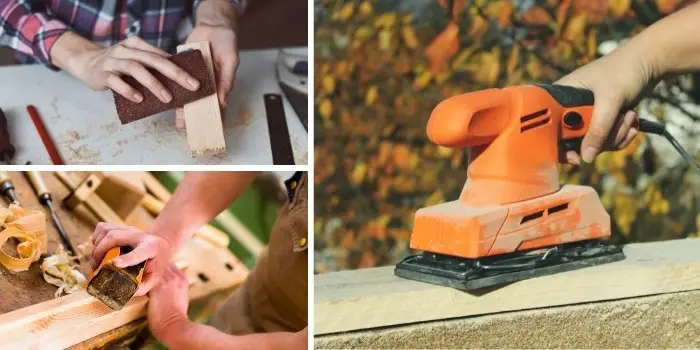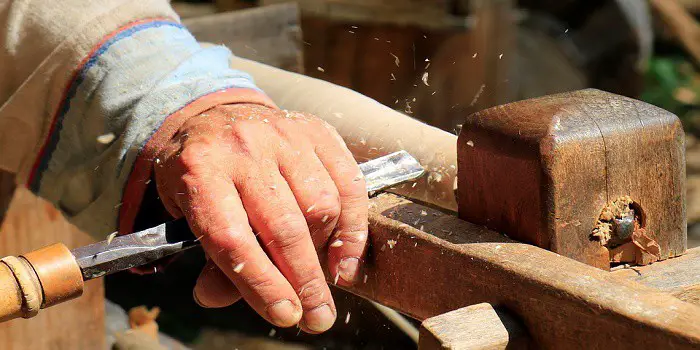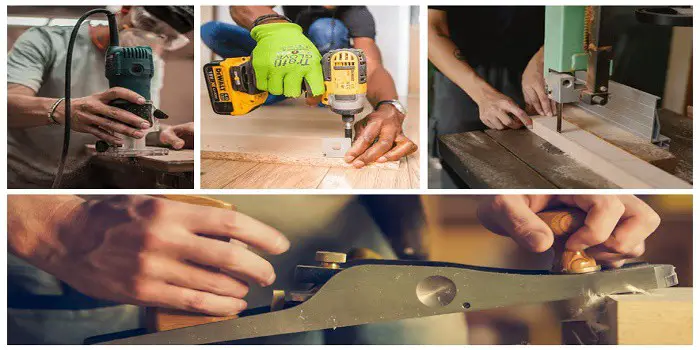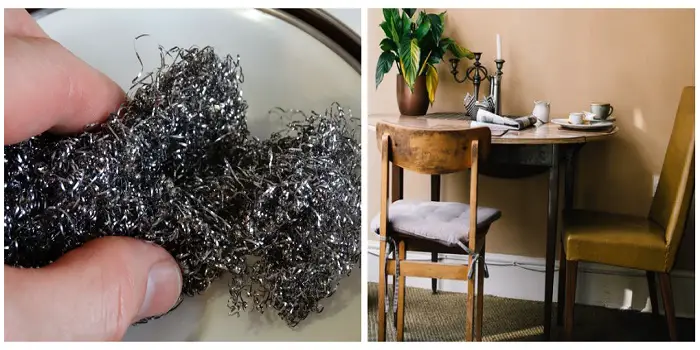
Sandpaper is a key tool in the process of removing paint from wood.
The type of sandpaper you use will determine how quickly and easily the paint comes off, as well as the amount of damage done to the underlying wood.
Using grit that is too coarse can result in deep scratches and gouges while using grit that is too fine can make the process much slower and more complex.
Generally, you should use 40 to 60-grit sandpaper to take the paint off the wood. However, to remove paint from edges, crevices, or other details your wood furniture or cabinetry may have, you must use a finer version, such as 80 to 120-grit sandpaper.
I would recommend testing with lighter sandpaper first before moving up in grit to avoid sanding more than necessary.
In this blog post, I’ll discuss in detail the different types of sandpapers to use for removing paint from wood, as well as the importance of using the correct grit.
I’ll also provide some tips on how to get the best results when removing the paint and then choose the right sandpaper on the market among the best ones available.
Read on to learn more!
Types of Sandpaper for Removing Paint
Sandpaper is rough paper with sand or other abrasive stuff stuck to it that’s used for smoothing or polishing wooden surfaces and other materials.
Let’s look at the most common types of sandpaper and the tasks used for them, as well as the standard grits…
1- Extra Coarse Sandpaper
(P24-P36)
As the name implies, extra-coarse sandpaper has a rough surface.
This type of sandpaper is ideal for aggressively removing thick coats of paint on wood.
However, because of its coarseness, it can potentially cause unwanted marks on softer wooden surfaces.
2- Coarse Sandpaper
(P40-P80)
If you are working with a material like solid wood door frames, tables, or cabinets, coarse sandpaper is your choice.
It can also take the wood primer off, often used as the base coat before painting the wood.
Coarse sandpaper is often used with a power sander tool like a belt sander.
3-Medium Coarse Sandpaper
(P80-P120)
This is a type of sandpaper with a grit level between coarse and fine.
This is an ideal grade for you if you are sanding down to take the paint off any carved wood surfaces.
4- Fine Sandpaper
(P120-P220)
This type of sandpaper is available in 120 and 220-grit grits, with the latter being finer.
In most DIY projects, this wood sandpaper will be enough. If you need to sand between coats, use fine-grit sandpaper.
Sandpaper with fine grains conforms to the shape of the wood more than sandpaper with coarse grains.
5- Extra-Fine Sandpaper
(P220-P500)
The extra-fine sandpaper has a grit level of around P220 to P500.
While this type of sandpaper may not get the paint removal job done, at least you know that this is an option available because you can afterward use this for polishing the wood to give it a final look.
Sandpaper Grit Chart for Paint Removal
| 40-60 Grit: | This is the coarsest type of sandpaper and is best used for removing thick layers of paint or varnish. |
| 80-120 Grit: | This is medium-coarse sandpaper and is best used for removing light layers of paint or varnish. |
| 200+ Grit: | This is fine-grit sandpaper and is best used for removing thin layers of paint or varnish and for final sanding before painting or staining. |
What is the Grit of Sandpaper?
Now that we’ve gone over the different types of sandpaper, let’s talk about grit.
The grit is essentially the measure of how rough or smooth the sandpaper is.
- The larger the number, the smoother the sandpaper will be.
- Conversely, the smaller the number, the more abrasive it will be.
Sandpaper is available in a wide range of grits, from very coarse (40-60 grit) to very fine (500+).
The grit type you need will depend on the paint you’re trying to remove, as well as the condition of the wood underneath.
As a general rule, always start with a coarse grit (40-60) and then move to the finer grit (80-120) once most of the paint has been removed.
For areas that are difficult to reach or are more delicate, you may need to use an even finer grit (200+) to avoid damaging the wood.

Using Sandpaper on Wood for Paint Removal
There are a few different ways that you can use sandpaper on wood…
1. By hand:
It’s the most common way to use sandpaper and is best for small projects or areas that are difficult to reach.
2. With an electric sander:
This is the best way to use sandpaper for large projects or remove multiple paint layers.
3. Using a sanding block:
Using a sanding block is the best way to use sandpaper to get into tight corners or sand large, flat surfaces.
Once you know how to use sandpaper on wood differently, you can start your project!
Here are a few sanding tips you may follow to get the best results…
- Always start with lower-grit sandpaper and work your way up to a higher grit.
- Use even pressure when sanding to avoid creating gouges in the wood.
- If it’s bare wood, sand with the grain of the wood, not against it.
- Wipe away any dust created by sanding before moving on to the next grit.
- When finished with sanding, wipe the wood with a damp cloth to remove any remaining dust.
Remember, sanding all the paint off the wood is not essential for your specific project.
If you need to refinish your wood item, scraping only the loose, cracking, chipping, or peeling paint is enough for most of the time.
Once this is done, the wood is ready for good bonding of fresh primer or paint.
How Much Time Does It Take to Remove the Paint?
It all depends on where you’re sanding.
For example, it usually takes 30 to 40 minutes to remove the old paint with the 60-grit sandpaper if you are working on a project like a window frame and sills.
You may need extra time if you need to sand your whole decking area or hardwood floors.
Also, when compared to sanding on a single layer of paint, sanding on several layers of paint may take longer to remove.
If you don’t have sandpaper or if you don’t want to use it for any reason, or if you just want to save time sanding huge surfaces, there are a few alternatives you can use for paint removal:
- power washer
- heat gun
- sandblasting
- liquid sandpaper
- chemical stripper
- solvents like paint thinner
Assuming you know how to handle these paint strippers, you can quickly remove any paint, stain, or varnish from your wood without damaging it.
How to Choose the Right Sandpaper Grit for Removing Paint?
There are a few different factors that you should consider when choosing the grit of sandpaper for removing paint from wood…
1. The type of paint you are removing
The type of paint matters much, like whether you are removing acrylic, latex, oil-based, or something other.
For example, if you are removing latex paint, you will need to use finer grit sandpaper.
Also, if you want to only remove a few layers of paint from the painted wood, you can use finer grit sandpaper.
However, if you are removing multiple layers of paint or the paint is very thick, you will need to use a coarser grit to get the job done quickly.
2. The condition of the wood
If the wood is in good condition, you can start with coarse grit and move to finer grit.
However, if the wood is damaged or has a lot of imperfections, you may need to start with the finer grit to avoid further damage.
3. The type of finish you want
For a smooth finish, you need to use finer grit sandpaper.
However, if you are not concerned about the finish and want to remove the paint, you can use a coarser grit.
4. The type of sander you are using
If you are using an electric sander, you will need to use finer grit sandpaper because electric sanders can damage the wood if you use a coarser grit.
The type of sander will also matter as these sanders are available in more than one different kind. The most common ones include the following:
a) Belt Sander:
A belt sander is a powerful tool that uses an abrasive sanding belt to remove material from a workpiece.
Belt sanders are typically used to quickly remove large amounts of material and can be used on many different types of materials, including wood, metal, and plastic.
b) Palm Sander:
A palm sander is a handheld power tool that uses an abrasive sanding pad to remove material from a workpiece.
Palm sanders are typically used to remove small amounts of material and can be used on many different materials, including wood, metal, and plastic.
c) Orbital or Disc Sander:
An orbital or disc sander is a handheld power tool that uses an abrasive disc to remove material from a workpiece.
Like palm sanders, the orbital sander is also a useful woodworking machine that can be used in removing small amounts of material.
You can use it on materials like wood, metal, and plastic.
5. The brand of the sandpaper you are buying
With several excellent sandpapers on the market, finding the proper balance between cost and performance may still be challenging.
Whether you’re working on a new DIY project or just trying to restore an old one, here are a few most popular brands you can pick from…
- BAISDY Wet Dry Sandpaper
- 3M General Purpose Sandpaper Sheets
- Fandel 36025 100 Grit Sandpaper Sheets Assorted
- 5-Inch 8-Hole Hook and Loop Sanding Discs by Miady Store
I have considered the grit, wood type, cost-to-quality ratio, sandpaper type, and skill level while choosing these finest sandpaper for woodworking and paint removal.
I have also gone through some honest customer reviews to ensure the products I recommend are still the best.
If you do not like them for any reason, you can search for more of them online – there are tons of them available besides these.
Share the post "What Grit Sandpaper To Use for Removing Paint from Wood?"

Hi, I am Mark Garner a professional carpenter, woodworker, and DIY painter. I live in the small city of Peoria, Arizona as a semi-retired woodworker. I have started this blog with a simple motive to help you with my wood experience in this sector. If you like to know more about what I love doing and how it all got started, you can check more about me here.




